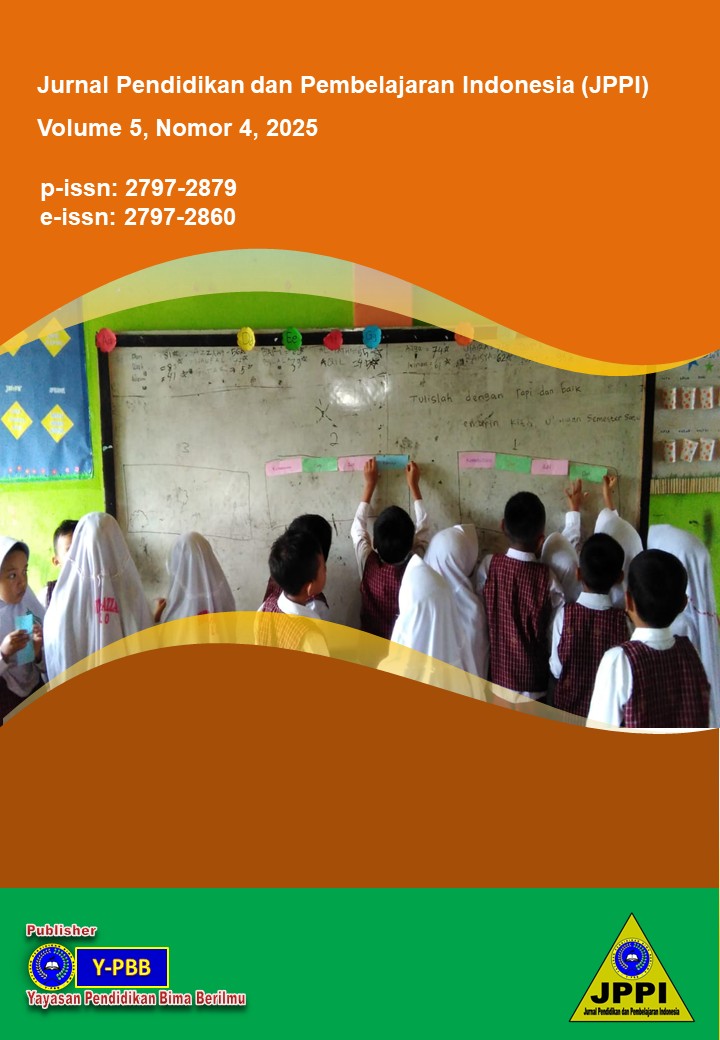English-Indonesian Translanguaging: Effects on EFL Students’ Vocabulary Acquisition and Concept Comprehension
DOI:
https://doi.org/10.53299/jppi.v5i4.2239Keywords:
Translanguaging, Vocabulary Acquisition, Concept ComprehensionAbstract
The purpose of this study is to examine the impact of English Indonesian translanguaging, the use of two languages simultaneously, on vocabulary acquisition and comprehension. The participants in this study were students from St. Maria Monte Carmelo Senior High School, Maumere, comprising 32 students from phases E1 and E2, who were selected through purposive sampling. The method employed was a descriptive qualitative approach, utilising instruments such as classroom observation, questionnaires, interviews, and vocabulary and concept understanding tests. The observation indicated that translanguaging was often used to explain the material and vocabulary, making it easier for students to learn the material. Then, the questionnaire data showed that the majority of students had a favourable view of translanguaging, indicating that students became more confident and comfortable while learning. In addition, the interviews revealed that students were not afraid to make mistakes due to the native language usage in the learning process. The test results showed that, on average, students demonstrated satisfactory vocabulary and concept understanding. This study suggests that translanguaging plays a crucial role in facilitating students' acquisition of new vocabulary and knowledge of concepts in the context of English as a foreign language.
References
Amblers, P. R. G., & Aper, N. A. A. N. (2010). T He L Egal E Ffect of V Oluntary S Elf -E Xclusion P Rograms for. Inquiry, 17(June), 85–92.
Cenoz, J., & Gorter, D. (2020). Pedagogical translanguaging: An introduction. System, 92, 102269. https://doi.org/10.1016/j.system.2020.102269
Cenoz, J., & Gorter, D. (2021). Pedagogical Translanguaging Jasone Cenoz and Durk Gorter (Vol. 4415).
Itoi, K. (2024). Fostering Inclusive Learning and 21st-Century Skills: Creating Translanguaging Spaces in University Content and Language Integrated Learning Courses. International Journal of Applied Linguistics (United Kingdom), 1–11. https://doi.org/10.1111/ijal.12643
Karatsareas, P. (2022). Semi-Structured Interviews. Research Methods in Language Attitudes, 99–113. https://doi.org/10.1017/9781108867788.010
Kurniawati, K., Santoso, S., & Utomo, S. (2021). the Effect of Snowball Throwing and Problem Based Learning Models on Students’ Social Science Learning Motivation At Grade Iv Sunan Ampel Demak Cluster. JURNAL PAJAR (Pendidikan Dan Pengajaran), 5(4), 1102. https://doi.org/10.33578/pjr.v5i4.8361
Lim, W. M. (2025). What Is Qualitative Research? An Overview and Guidelines. Australasian Marketing Journal, 33(2), 199–229. https://doi.org/10.1177/14413582241264619
Mbirimi-Hungwe, V., & McCabe, R. M. (2020). Translanguaging during collaborative learning: A ‘transcollab’ model of teaching. Southern African Linguistics and Applied Language Studies, 38(3), 244–259. https://doi.org/10.2989/16073614.2020.1847670
Nyimbili, F., & Nyimbili, L. (2024). Types of Purposive Sampling Techniques with Their Examples and Application in Qualitative Research Studies. British Journal of Multidisciplinary and Advanced Studies, 5(1), 90–99. https://doi.org/10.37745/bjmas.2022.0419
Peng, J. (2024). English Language Teaching Methods: Exploring the Impact of Various Approaches on Students’ Language Learning Outcomes. SHS Web of Conferences, 187, 01008. https://doi.org/10.1051/shsconf/202418701008
Puspitasari, P. T., & Sugirin. (2024). Translanguaging Used in Speaking Class of Non-Formal Education Program : Students ’ and Teachers ’ Perceptions. International Journal of Contemporary Studies in Education, 3(1), 13–21.
Raja, F. D., Suparno, S., & Ngadiso, N. (2022). Students’ Attitude Towards Translanguaging Practice in Indonesian EFL Classes. AL-ISHLAH: Jurnal Pendidikan, 14(1), 979–988. https://doi.org/10.35445/alishlah.v14i1.1149
Rao, P. S. (2019). The Role of english as A Global Language. Reseasch Journal of English (RJOE), 4(1), 65–79. www.rjoe.org.in
Renandya, W. A., & Chang, A. C. S. (2022). Translanguaging: Does It Work in EFL Contexts? Tesl-Ej, 26(3), 1–3. https://doi.org/10.55593/ej.26103a25
Sanjaya, M. M., & Sumardi, J. N. (2023). Students’ FLA and their perspectives on translanguaging practices in Indonesian EFL classrooms. English Language & Literature International Conference, 6(1), 406–420.
Sharma, H. (2022). How short or long should be a questionnaire for any research? Researchers dilemma in deciding the appropriate questionnaire length. Saudi Journal of Anaesthesia, 16(1), 65–68. https://doi.org/10.4103/sja.sja_163_21
Sloman, K. N. (2010). Research trends in descriptive analysis. The Behavior Analyst Today, 11(1), 20–35. https://doi.org/10.1037/h0100686
Tai, K. W. H. (2025). Unequal translanguaging: the affordances and limitations of a translanguaging space for alleviating students’ foreign language anxiety in language classrooms. Applied Linguistics Review, 1–45. https://doi.org/10.1515/applirev-2025-0049
Ularte, M. B. (2019). Class Observation in Science: Tool in Reshaping Teaching and Learning. Instabright International Journal of Multidisciplinary Research, 1(1), 19–27. https://doi.org/10.52877/instabright.001.01.0014
Wei, L., & García, O. (2022). Not a First Language but One Repertoire: Translanguaging as a Decolonizing Project. RELC Journal, 53(2), 313–324. https://doi.org/10.1177/00336882221092841
Downloads
Published
Issue
Section
License
Copyright (c) 2025 Jurnal Pendidikan dan Pembelajaran Indonesia (JPPI)

This work is licensed under a Creative Commons Attribution 4.0 International License.














